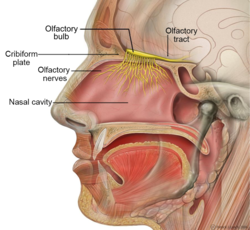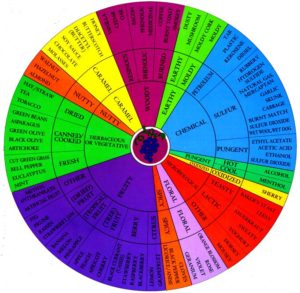Our Amazing Sense of Smell
In the October 4 article, I touched on the topic of retronasal olfaction. While researching this additional nerve center that enables us to smell, I discovered fascinating facts about our amazing sense of smell. This post is dedicated to the most important sense as we learn about and enjoy wine. Our tongues can only perceive the tastes of sweet, salt, bitter, sour, and the more elusive “umami.” This means that our noses have to do most of the work that enables us to taste wine.
Consider the following staggering statistics:
– More than 1,300 volatile compounds have been identified in alcoholic beverages (elements we can smell).
– Of the one million genes in the human genome, thirty thousand are solely dedicated to encoding smells.
– Our sensitivity to certain smells is truly remarkable; for example, we can detect the unpleasant odor of hydrogen sulfide in concentrations of just three parts per billion.
– Our sensitivity to smells ranges tremendously. In a group of 10 people, there can be as much as a ten thousand-fold differential from the most to least sensitive noses, meaning that there would have to be 10,000 more parts of a particular compound for the least sensitive nose to perceive.
Now that we understand a bit more about the sensitivity of our noses and olfactory systems, we’re ready to practice smelling a wine! Temperature is very important. I used to drink my white and sparkling wines too cold. At some point, I realized I couldn’t smell much when a wine was overly chilled. You still want your white and rose wines chilled and your Champagnes and sparkling wines cold, but not icy. Most people know to swirl – this applies to all wines except sparkling. The swirling is best accomplished by placing the glass on the table, holding the stem, and rapidly moving it in small circles. This aerates the wine and also coats a larger amount of the surface of the glass, releasing more aromas into the air.
To effectively smell the wine, place your nose into the glass and take several short, quick sniffs. Lower the glass and quickly assess what you think you smelled. Identifying perceived aromas is difficult for most people. The nose fatigues quickly and when exposed to many aromas at once, it may only be possible to identify a few. Master Sommelier Tim Gaiser suggests another technique when smelling wine – approach the glass as you normally would but then slightly open your mouth and breathe gently through the nose and mouth at the same time. This is referred to as active inhalation and enables us to smell with both the nose and mouth. Tim says, “The difference is usually noticeable for most, revelatory for some.”
A technique I have heard about and tried is a fun way to teach your nose to identify scents and aromas. Purchase an assortment of fruits, vegetables, herbs, spices, and flowers. Practice smelling several – maybe a green pepper, a lemon, strawberries, a rose, and cinnamon. The next time you taste a Cabernet Sauvignon or Cabernet Franc, you may immediately be able to identify the green pepper aroma. Similarly, you may pick up on the citrus in unoaked Chardonnays or Sauvignon Blancs and perhaps the fresh strawberry aromas in a Grenache.
In the end, all that really matters is that you enjoy the wine you are drinking. But it is fun to know that you are developing your sense and awareness of smell that is so crucial to the appreciation of wine. Keep practicing!
Credits
Karen MacNeil, author of The Wine Bible
Fun and informative website and blog, Wine Folly. You can purchase a wine flavor wheel from them – I did!



 Lisa Gorham
Lisa Gorham
Leave a comment